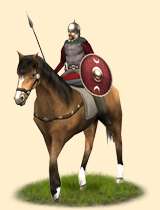Eqvites Gallorvm (Gallic Auxiliary Cavalry)
 |
Weapons | Defence | Mental | ||||||
|---|---|---|---|---|---|---|---|---|---|
| Primary | Secondary | Armour: | 9 | Morale: | 11 | ||||
| Type: | spear | spear | Shield: | 2 | Discipline: | impetuous | |||
| Attack: | 4 | 3 | Skill: | 8 | Training: | trained | |||
| Charge: | 30 | 30 | Recruitment | Other | |||||
| Lethality: | 1 | 0.33 | Soldiers: | 25 | Hit Points: | 1 | |||
| Range: | 55 | 0 | Cost: | 2232 | Mass: | 1 | |||
| Ammo: | 8 | 0 | Upkeep: | 558 | |||||
| Turns: | 1 | ||||||||

The Gallic tribes within the borders of the Res Publica supply the roman army with effective and versatile medium horsemen that have become the backbone of the roman cavalry arm.
Equites Gallorum are a versatile medium cavalry equipped for both, skirmishing and shock actions. Besides their main lances, every rider carries several light javelins to weaken the enemy formations and some of them also a Celtic long sword for close combat. Other than many of their counterparts from free Celtic tribes the horsemen recruited in our provinces are comparably well protected and better prepared to fight the enemy at close quarters. Each eques defensive gear consists of a good quality bronze helmets, a small round shields and a shirt of lorica hamata (chain mail). Additionally Equites Gallorum now use the four horned saddle, a new and very useful supplementation to cavalry equipment, that enables a firm seat in almost all situations.
Drawn from the upper classes of local Celtic societies these are well trained and respected warriors that have become an integral part of many armies of the Res Publica. Together with other auxiliaries they give our legions the much needed effective cavalry support and are a worthy replacement for the roman equites of previous centuries. Gallic cavalry can ride down skirmishers, protect the flanks of the infantry or prepare their attack with their javelins while they are always capable to charge at the right opportunity. However they are still medium cavalry and a supporting force, it should never be expected that they alone can win a battle.
Historically, various auxiliary cavalry completely replaced the Italic contingents in the roman armies of the late republic and Celtic horsemen were seen as one of the best in the roman realm. At the time of Julius Caesar they had become the backbone of the army’s cavalry arm, fighting with roman forces at places very far away from Gaul as Egypt and Mesopotamia. Celtic and Iberian tactics, fighting style and vocabulary remained dominant in the later regular cavalry arm of the imperial army well into the 2nd century AD, when the major recruitment areas for cavalrymen had shifted to other provinces for many decades.
Allied and subdued states and tribes always had to supply the roman army with troops. Almost at all times at least 50% of Roma’s soldiers were non-citizens. During the first centuries of the republic the old alae of the Italic socii were organized and equipped in a similar way to the roman legions, but around the beginning of the 1st century BC the situation changed. After the social war almost all free people of Italia received roman citizenship and could now be recruited into the regular legions. In the decades after the “marian reforms” the roman light infantry disappeared. The ordo equester, since decades unable to provide a sufficient number of cavalry for the many wars the late republic had to fight, had split off in two main groups. A mainly political elite that filled out the numerous officer and administrative posts the ever growing Res Publica had to offer, and a pure economical elite, the large majority of the Roman and Italic equestrians.
The various different peoples now ruled by the republic were a much more heterogeneous group than the former Italic socii. Depending on their relative military strengths, they had to supply the roman army with the various troop types needed, besides heavy infantry, in order to be competitive on the battlefield.
Most of these troops were levied in the surrounding areas under roman control prior to campaign and only large scale or intesively prepared wars demanded additional forces and specialised units from distant areas of the Roman world. Many of the auxiliaries fought under their own chieftains and officers, while others, especially those recruited from regular provinces, were commanded by roman officers and even organized in roman manner. Usually the auxiliary units were disbanded and sent home after the end of a conflict. However, in the continuous wars during the last decades of the republic many served so long alongside the legions and fought for their generals that they were largely Romanized in the end.